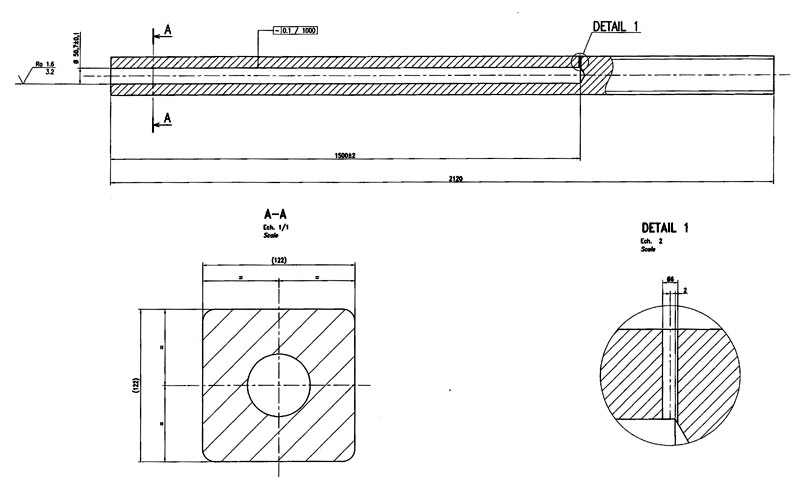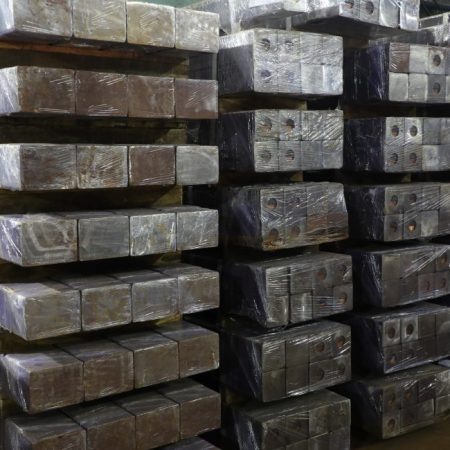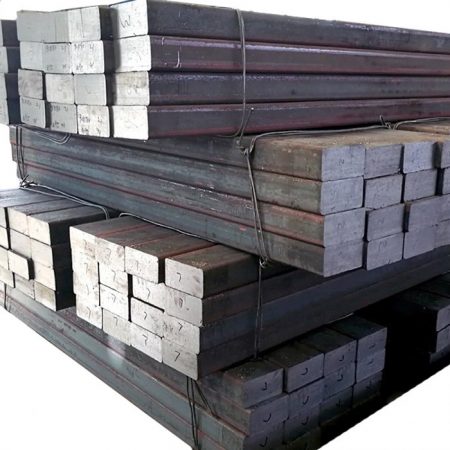Here we introduce ASTM Grade 1006 low carbon steel cothode collector bar for Electrolytic Aluminium workshop producing and inspection requirement. If you are interested in it, please write email to [email protected].

The steel collector bars have a square cross-section with round copper insert. The quality of steel and copper insert, their dimensions and its fitting in the finished collector bar should be as below and in accordance with the drawing:
- Physical:
1.1 Steel collector bar tolerance:
Length (mm) 0 / +10
Width (mm) -2~+2
Height (mm) -2~+2
1.2 Steel collector bar geometrical tolerances
– Angle defect at cut end less than 5 mm
– Flatness at cut ends less than 2 mm
– Angle defect of cross-section less than 3 mm
– Deflection on the whole bar less than 3 mm
(Laterally and Vertically)
– Local deflection less than 3 mm per meter
(Laterally and Vertically)
– Flatness less than 3 mm
(Transversally and vertically)
– Twist less than 3 mm per meter
– Round off 4-15 mm
1.3 Steel collector bar surface condition
– Lateral surfaces: Free or metal pickup and cracks deeper than 3 mm
– Surface roughness not projecting by more than 1 mm
– Cut by saw (Cutting with shears or oxyacetylene torch are prohibited unless followed by grinding). Cuts must not present manufacturing defects (Necessitating a supplementary grinding).
– No painting on the bar ends.
- Physicochemical characteristics
2.1 Composition of collector bar steel (Gravimetrical analysis)
The cathode bar application requires a ferrous metal with a relatively low electrical resistivity and a good weldability (For example 1020 Grade or ASTM A29/A29 M-99) and following composition requirement:
Carbon: ≤0.06%
Silicon: ≤0.07%
Manganese: ≤0.45%
Phosphorus: ≤0.03%
Sulphur: ≤0.04%
Nitrogen ≤0.012%.
The steel supplier must supply to the client its proposal with typical steel composition range expected for the following chemical elements: Al, C, Cr, Cu, Si, Mn, Ni, S, P & N
- Cathode bar inspection
Acceptance of cathode bars takes place in the supplier’s premises and includes:
– A check of the quality control results of the supplier, and especially a check of the analysis certificates guaranteeing that the quality of the bar steel meets the requirements of the specification
– A check of bar dimensions is aspect.
As regards inspection procedures, the word “LOT” means “LOT of material to be inspected”, i.e. All the cathode bars, out of which a sample will be taken to check for compliance with the acceptance criteria.
The cathode bards in a given LOT must be manufactured according to the same process and with the same quality of steel.
NB: When there is no acceptance on site, all the supplier control results must be sent to the client purchasing department before shipping for acceptance.
3.1 Acceptance inspection procedure
The acceptance inspection is performed by a representative of an external organization approved by the client.
Supplier results
Supplier must present results as the beginning of acceptance, including as a minimum:
– The chemical composition
– The dimensional check
– Around-off check
– An angle defect checks (cross section and cut-end)
– A total deflection checks
– A twist checks
All the dimensional and appearance controls are carried out according to a singles sampling scheme for normal inspection (Based on standard ISO 2859 AQL 1.5%).
All results that do not comply with the requirements given must be identified.
When the number of defective bars is less than or equal to the lot acceptance criterion, the lot is in conformity.
When the number of defective bars is equal to or greater than the lot rejection criterion, the lot is not in conformity.
When client’s representative arrives, they check the suppliers results and their measurement apparatus. These results are to be appended to the acceptance report.
As fa as the steel composition in concerned, the lot is rejected if the results of the analysis certificates do not comply with the requirements or if at least one of the specified element results is not supplied.
3.2 Dimensional inspection
The bar length, width and height are checked by the attribute as per standard ISO 2859 by the clients representative. The inspection in performed according to the single sampling scheme for normal or reduced inspection with an AQL of 1.5%.
Each bar is classified “defective” or “not defective”, depending respectively on whether the 3 dimensions comply with the tolerances given or whether one of more of the 3 dimensions are out of tolerance. The defective bars are rejected.
When the number of defective bars is less than or equal to the lot acceptance criterion, the lot is accepted.
When the number of defective bars is equal to or greater than the lot rejection criterion, the number of test specimens has to be increased as described bars from this lot must only be presented again after re-examination of all the parts and elimination of the defective bars.
The dimensions are measured as follows:
– Length: Place the bar on horizontal working surface with a retaining edge. Place one of the ends of the bar against the edge and place the set square against the other end. Use a tape measure to determine the overall length of the bar between the edge and set square. Record the length measurement on an inspection sheet.
– Width and height: measure these 2 dimensions at the center of the bar with a caliper gauge. Acord all the results on an inspection sheet, which is appended to the acceptance report.
Remarks: The defective bars are rejected after being taken into account for lot acceptance.
3.3 Geometrical inspection
These characteristics are checked by attributers in a single sampling scheme with an AQL of 1.5% each bar in classified “defective” or “not defective”, depending on the results of the 8 measurements that have to be done:
– Bar defective: At least 1 of the 8 measurements is out of tolerance
– Bar not defective: The 8 measurements comply with the tolerances.
The defective bars are rejected but counted.
The characteristics are measured as follows:
– Total deflection (2 measurements): This is measured on one horizontal and on one vertical face (concave surfaces). Place a rigid ruler longer than the bar on the surface being checked. It must not be possible to insert the 3 mm thick shim between ruler and bar.
– Local deflection (2 measurements): This is measured on one horizontal and on one vertical face (Concave surfaces). Place a 1 m rigid ruler on the surface being checked. It must not be possible to insert the 3 mm thick shim between ruler and bar. Repeat the operation three times by face to check the entire bar length.
– Angle defect at cut end (2 measurements): The perpendicularity is checked at both ends of the bar along the width and height using a set square and the 5 mm thick shim. It must not be possible to insert the shim between set square and end of bar.
– Angle defect of cross-section (2 measurements): The check is made in the middle of the bar along the width and height using a set square and the 3 mm thick shim. It must not be possible to insert the shim between set square and bar.
The results from all these checks are recorded on an inspection sheet appended to the acceptance report.
– OK: Dimensions within tolerances.
– D*: Dimensions out of tolerance (defective).
– 1: First bar rejected.
3.4 Surface condition inspection
The acceptance rules are same as those specified, the surface condition of the sample bars are checked visually. Their aspect must comply with the dimension given. Use the depth gauge to measure the depth of any defects.
The flatness at cut ends (2 measurements) is checked at both ends of the bar using a set square and the 2 mm cylindrical shim. It must not be possible to insert the cylindrical shim between set square and end of bar.
3.5 Acceptance report
On completion of acceptance, a report is prepared to include at least the following:
– The references of manufacturer and plant,
– The lot number,
– The bar dimensions,
– The number of bars presented, rejected and accepted.
The acceptance report is signed by the representatives of the client and supplier. The analysis certificates and various supplier and client inspection sheets are appended to the acceptance report and attachments.

Reference documents:
ASTM A572 Gr 50 Hot rolled products of non-alloy structural steels – Technical delivery conditions
ASTM A36/A36M-14 Standard specification for Carbon structural steel
ASTM A1018/A1018M-16a Standard specification for steel, sheet and strip, heavy-thickness coils, Hot-rolled, Carbon, Commercial, Drawing, Structural, High-strength Low-alloy, High-strength Low-alloy with improved formability, and Ultra-high strength.






